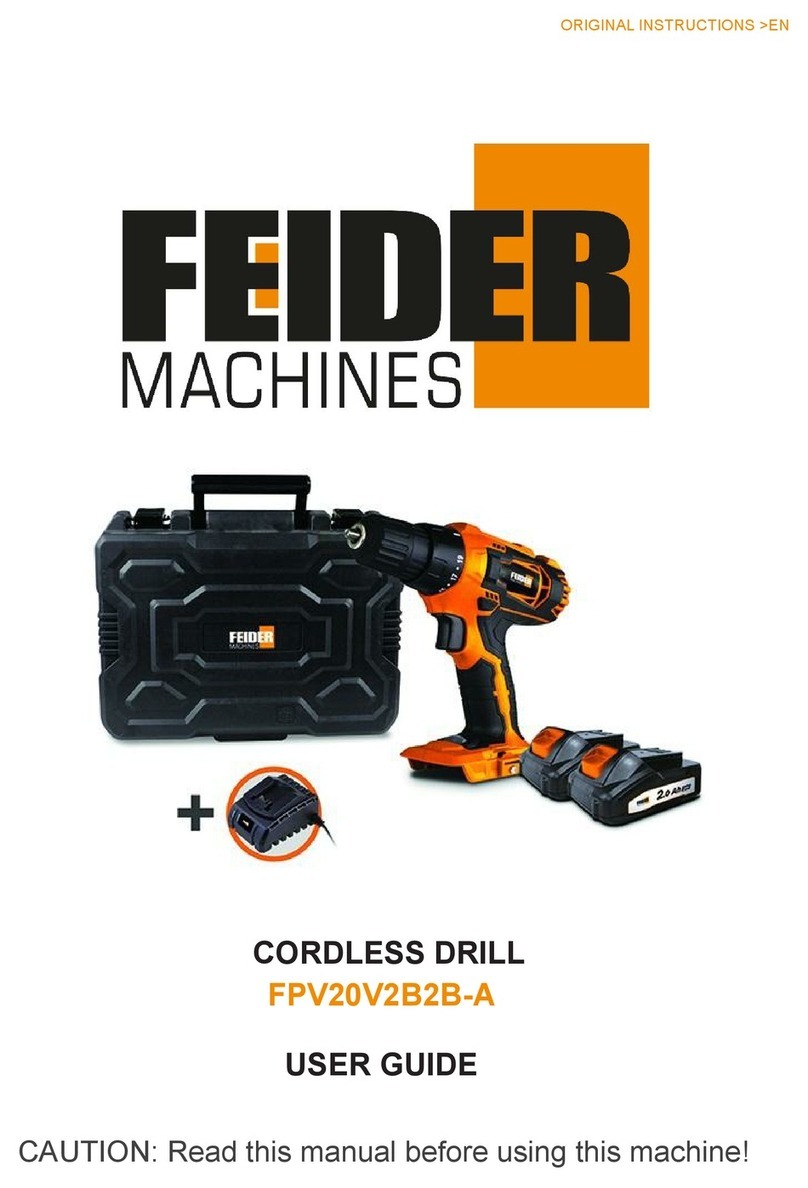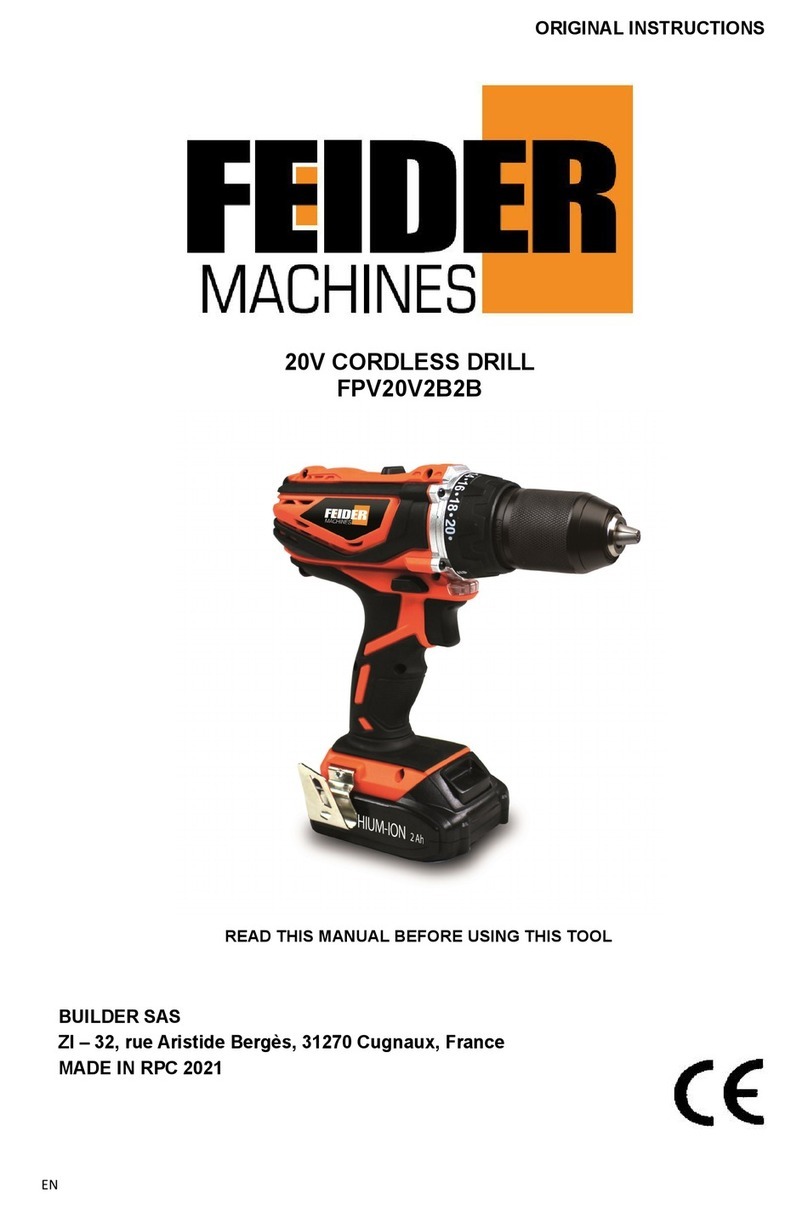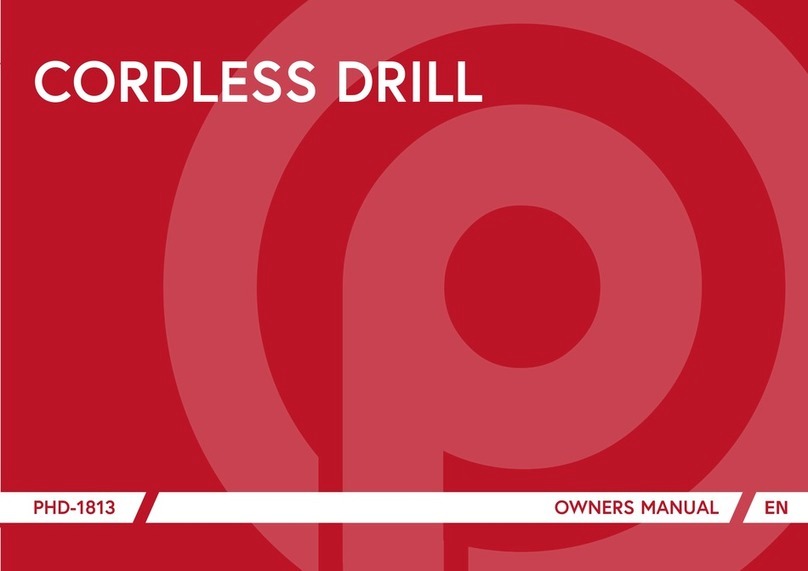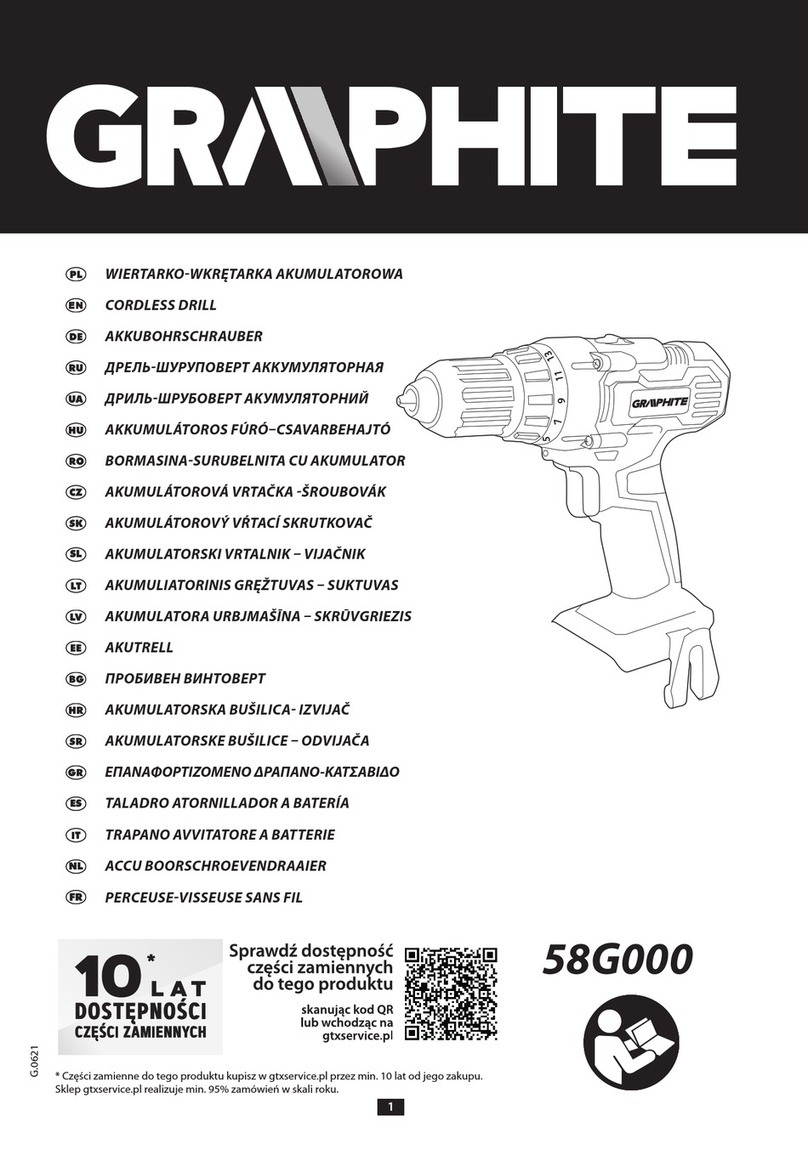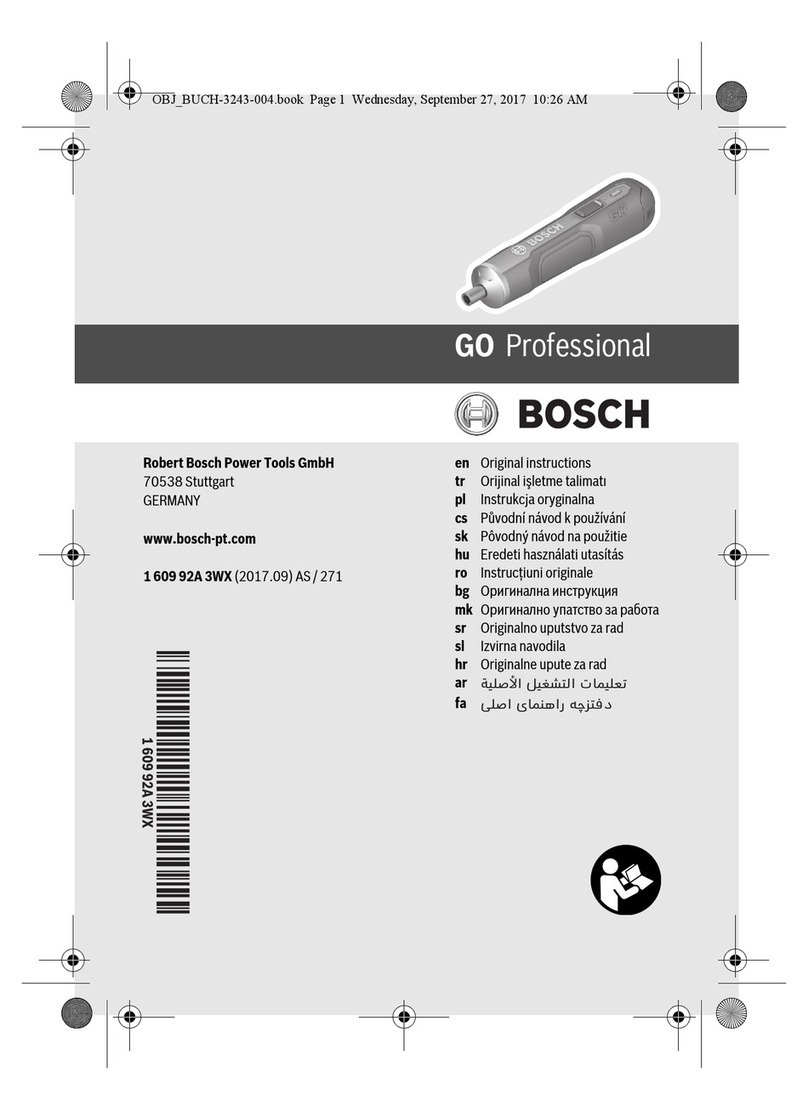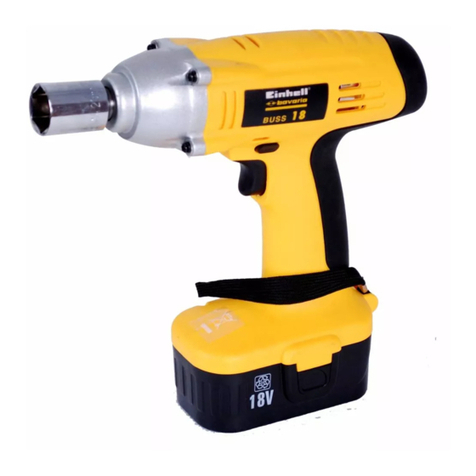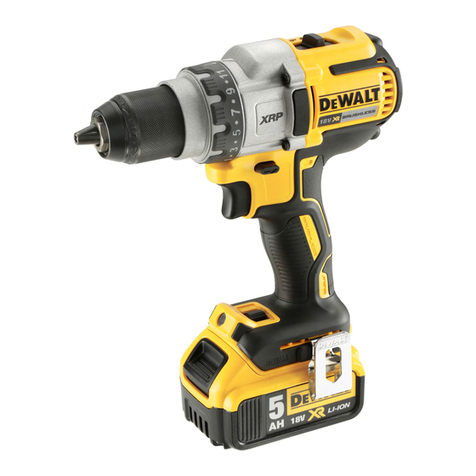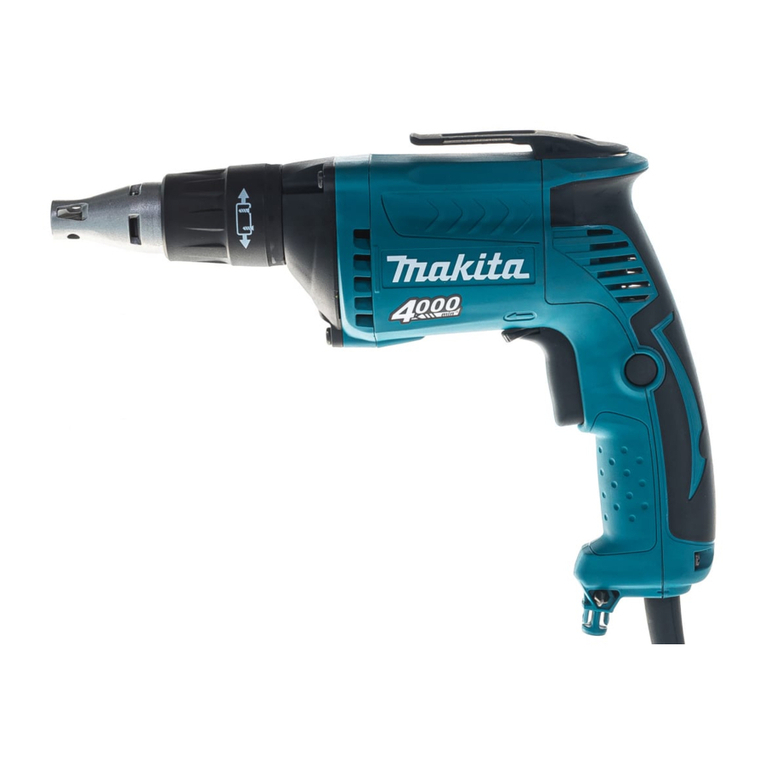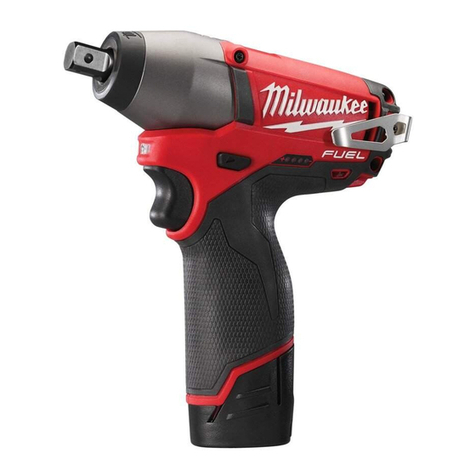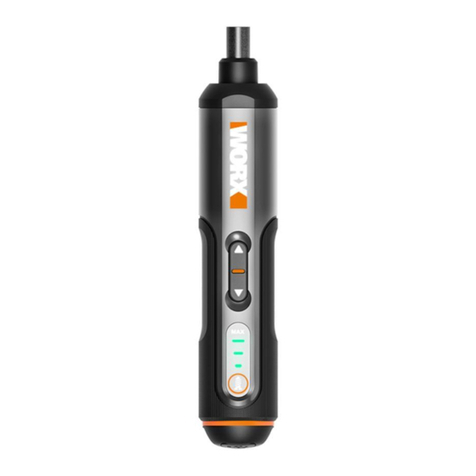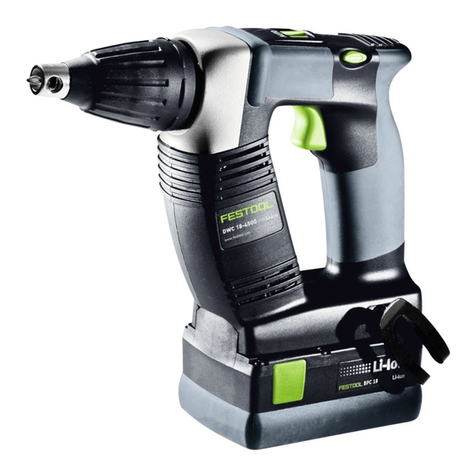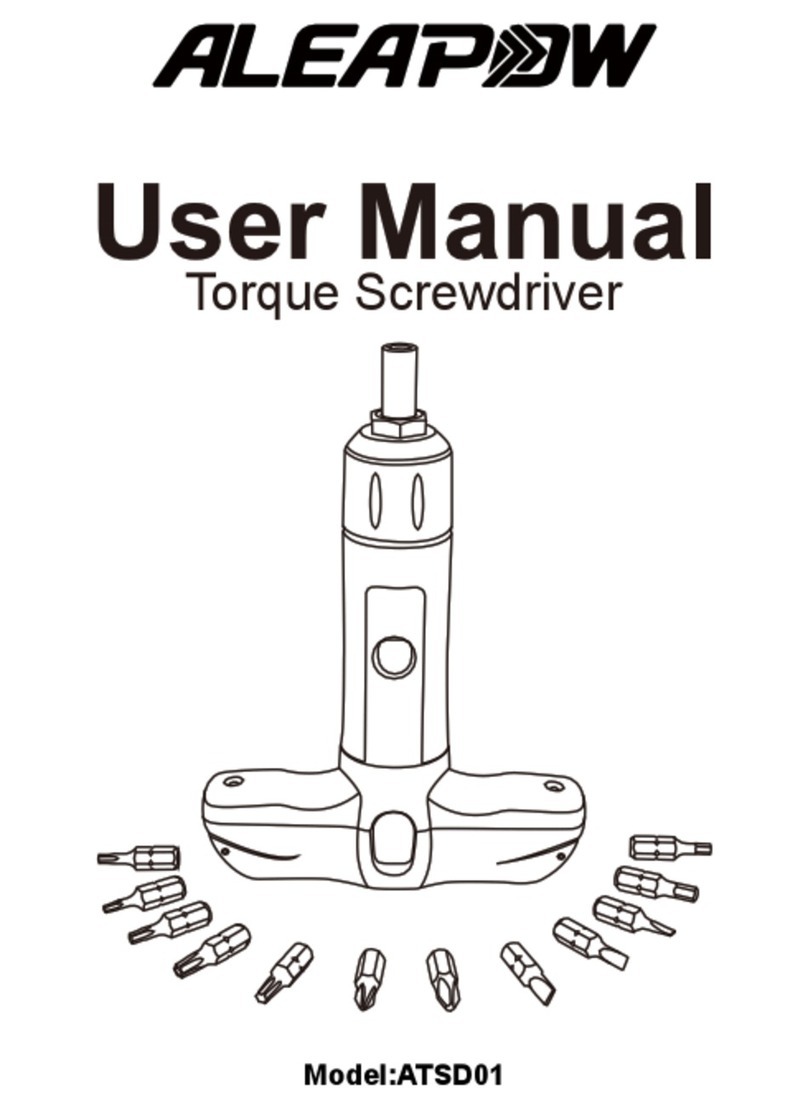Feider Machines FPV20V2B2B User manual

ORIGINAL INSTRUCTIONS
CORDLESS DRILL
FPV20V2B2B
READ THESE INSTRUCTIONS BEFORE USE THIS TOOL
FEIDER
32, rue Aristide Bergès - ZI 31270 Cugnaux –France

CONTENTS
1. SAFETY INSTRUCTIONS 3
2. ABOUT YOUR PRODUCT 9
3. USE AND FUNCTION 11
4. MAINTENANCE AND STORAGE 14
5. DISPOSAL 14
6. CE DECLARATION 15

1. SAFETY INSTRUCTIONS
WARNING Read all safety warnings and all instructions. Failure to follow the
warnings and instructions may result in electric shock, fire and/or serious injury.
Save all warnings and instructions for future reference. The term "power tool" in the
warnings refers to your mains-operated (corded) power tool or battery-operated (cordless)
power tool.
1) Work area safety
a) Keep work area clean and well lit. Cluttered or dark areas invite accidents.
b) Do not operate power tools in explosive atmospheres, such as in the presence of
flammable liquids, gases or dust. Power tools create sparks which may ignite the dust or
fumes.
c) Keep children and bystanders away while operating a power tool. Distractions can
cause you to lose control.
2) Electrical safety
a) Power tool plugs must match the outlet. Never modify the plug in any way. Do not
use any adapter plugs with earthed (grounded) power tools. Unmodified plugs and
matching outlets will reduce risk of electric shock.
b) Avoid body contact with earthed or grounded surfaces, such as pipes, radiators,
ranges and refrigerators. There is an increased risk of electric shock if your body is earthed
or grounded.
c) Do not expose power tools to rain or wet conditions. Water entering a power tool will
increase the risk of electric shock.
d) Do not abuse the cord. Never use the cord for carrying, pulling or unplugging the
power tool. Keep cord away from heat, oil, sharp edges or moving parts. Damaged or
entangled cords increase the risk of electric shock.
e) When operating a power tool outdoors, use an extension cord suitable for outdoor
use. Use of a cord suitable for outdoor use reduces the risk of electric shock.
f) If operating a power tool in a damp location is unavoidable, use a residual current
device (RCD) protected supply. Use of an RCD reduces the risk of electric shock.
NOTE the term “residual current device (RCD)” may be replaced by the term “ground fault
circuit interrupter (GFCI)” or “earth leakage circuit breaker (ELCB)”.
3) Personal safety
a) Stay alert, watch what you are doing and use common sense when operating a power
tool. Do not use a power tool while you are tired or under the influence of drugs, alcohol
or medication. A moment of inattention while operating power tools may result in serious
personal injury.
b) Use personal protective equipment. Always wear eye protection. Protective equipment
such as dust mask, non-skid safety shoes, hard hat, or hearing protection used for appropriate
conditions will reduce personal injuries.
c) Prevent unintentional starting. Ensure the switch is in the off-position connecting to
power source and/or battery pack, picking up or carrying the tool. Carrying power tools
with your finger on the switch or energizing power tools that have the switch on invites
accidents.
d) Remove any adjusting key or wrench before turning the power tool on. A wrench or a

key left attached to a rotating part of the power tool may result in personal injury.
e) Do not overreach. Keep proper footing and balance at all times. This enables better
control of the power tool in unexpected situations.
f) Dress properly. Do not wear loose clothing or jewellery. Keep your hair, clothing and
gloves away from moving parts. Loose clothes, jewellery or long hair can be caught in
moving parts.
g) If devices are provided for the connection of dust extraction and collection facilities,
ensure these are connected and properly used. Use of dust collection can reduce
dust-related hazards.
4) Power tool use and care
a) Do not force the power tool. Use the correct power tool for your application. The
correct power tool will do the job better and safer at the rate for which it was designed.
b) Do not use the power tool if the switch does not turn it on and off. Any power tool that
cannot be controlled with the switch is dangerous and must be repaired.
c) Disconnect the plug from the power source and/or the battery pack from the power
tool before making any adjustments, changing accessories, or storing power tools.
Such preventive safety measures reduce the risk of starting the power tool accidentally.
d) Store idle power tools out of the reach of children and do not allow persons
unfamiliar with the power tool or these instructions to operate the power tool. Power
tools are dangerous in the hands of untrained users.
e) Maintain power tools. Check for misalignment or binding of moving parts, breakage
of parts and any other condition that may affect the power tool’s operation. If damaged,
have the power tool repaired before use. Many accidents are caused by poorly maintained
power tools.
f) Keep cutting tools sharp and clean. Properly maintained cutting tools with sharp cutting
edges are less likely to bind and are easier to control.
g) Use the power tool, accessories and tool bits etc. in accordance with these
instructions, taking into account the working conditions and the work to be performed.
Use of the power tool for operations different from those intended could result in a hazardous
situation.
5) Battery tool use and care
a) Recharge only with the charger specified by the manufacturer. A charger that is
suitable for one type of battery pack may create a risk of fire when used with another battery
pack.
b) Use power tools only with specifically designated battery packs. Use of any other
battery packs may create a risk of injury and fire.
c) When battery pack is not in use, keep it away from other metal objects, like paper lips,
coins, keys, nails, screws or other small metal objects, that can make a connection from
one terminal to another. Shorting the battery terminals together may cause burns or a fire.
d) Under abusive conditions, liquid may be ejected from the battery; avoid contact. If
contact accidentally occurs, flush with water. If liquid contacts eyes, additionally seek
medical help. Liquid ejected from the battery may cause irritation or burns.
6) Service

a) Have your power tool serviced by a qualified repair person using only identical
replacement parts. This will ensure that the safety of the power tool is maintained.
Drill safety warnings
- Wear ear protectors when impact drilling. Exposure to noise can cause hearing loss.
NOTE the above warning applies only to impact drills and may be omitted for drills other than impact drills.
- Use auxiliary handle(s), if supplied with the tool. Loss of control can cause personal
injury.
- Hold power tool by insulated gripping surfaces, when performing an operation
where the cutting accessory may contact hidden wiring. Cutting accessory contacting
a "live" wire may make exposed metal parts of the power tool "live" and could give the
operator an electric shock.
Additional instructions
- Charger and battery are sold separately. Please buy recommended battery and charger.
- The electrical current used must correspond to the specifications of the battery charger;
read carefully the instructions and technical specifications of the charger and the battery.
- Never allow moisture, rain or splash to reach the recharging location.
- The ambient temperature should never exceed 40 ° C. Never expose the unit to direct
sunlight.
- A faulty or damaged battery pack or no longer accepting a load must be disposed of at a
special collection point. Respect the environment. Do not dispose of an unusable battery
pack with household waste in the fire or in water.
- Always keep the surface of the charger free of dust and dirt.
- Always remove the battery pack before performing any operation or maintenance on the
device.
Residual risks
Even with use of the tool as described, it is impossible to eliminate all residual risk factors. The
following hazards may be present in connection with the construction and design of the tool:
1. Pulmonary lesions if an effective mask is not worn.
2. Hearing damage if effective hearing protection is not worn.
3. Body injuries caused by vibration emissions if the electrical appliance is used improperly or
for a prolonged or poorly maintained period.
WARNING! This device produces an electromagnetic field during operation. This field may
interfere in certain circumstances with active or passive medical implants. To reduce the risk of
serious or fatal injury, we recommend that people with medical implants consult with their
physician and the medical implant manufacturer before using this device.
Intended Use
This power tool is designed for drilling as well as for tightening and loosening screws. Specially
design to work with Feider range of battery and charger.
This power tool should not be used for purposes other than those described.
FBA20V2A
20V 2A LITHIUM ION
BATTERY
NOT INCLUDED IN
PACKAGE
FBA20V4A
20V 4A LITHIUM ION
BATTER
NOT INCLUDED IN
PACKAGE
FCH20V
20V LITHIUM ION BATTERY
CHARGER
NOT INCLUDED IN
PACKAGE

Explanation of symbols
Do not dispose of old appliances with domestic rubbish
To reduce the risk of injury, the user must read and
understand this manual before using this product.
Conforms to relevant safety standards
Do not expose batteries to temperatures exceeding 40
degrees.
Do not dispose of batteries in fire. They could explode and
cause injury
Do not dispose of batteries in water.
Recycling

2. YOUR PRODUCT
a. Description
1. 1st/2nd gear switch
lever
2. Torque adjustment
ring for driving/drilling
3. Chuck jaw setting
4. Chuck jaw
5. LED light
6. Forward/reverse
switch
7. ON/OFF trigger switch
8. Hand grip
9. Battery release catch
(on battery)
10. Battery pack
11. Belt clip
The tool is provided is with a clip for the belt.
b. Technical data
Voltage
20Vdc
No load speed
0-440/0-1650/min
Chuck
ɸ13mm
Sound power level
LwA : 82dB(A) K=3dB(A)
Sound pressure level
LpA: 71 dB(A) K=3dB(A)
Vibration
3m/s²
K=1,5m/s²

Information:
The declared vibration total value has been measured in accordance with a standard test
method and may be used for comparing one tool with another;
The declared vibration total value may also be used in a preliminary assessment of
exposure.
Warning:
that the vibration emission during actual use of the power tool can differ from the declared
total value depending on the ways in which the tool is used; and
of the need to identify safety measures to protect the operator that are based on an
estimation of exposure in the actual conditions of use (taking account of all parts of the
operating cycle such as the times when the tool is switched off and when it is running idle
in addition to the trigger time).
Wear hearing protection.
IMPORTANT
This tool is provided without battery and battery charger. Please buy a battery pack
(battery + charger) from the same trademark of this screwdriver. The recommended
product is: FEIDER 20V LITHIUM ION BATTERY CHARGER. Do not use non
recommended battery.
Bits are not provided with this tool. You can buy 1/4 hexagonal bits to use with this tool.
For more information, ask advice to your retailer.
3. OPERATION
a. Charging
FEIDER range battery and charger are not sold together with this cordless drill.
You must buy separately these elements.
Battery has not been fully charged at the factory. Follow the instructions for
charging before use.
Before using it for the first time, charge the battery for 60min to 130min. Insert the charger
plug into the charging socket and plug the charger into a 230V/50Hz electrical outlet
(check the electrical specifications of battery and the charger before use and read
carefully the instruction manual for battery and charger).
Charge status
To display the amount of charge left on the battery, press the charge level indicator.

The battery is fully charged when the 4 indicators are illuminating.
b. Installation of the battery pack
Warning! Always remove the battery from the tool when assembling accessories,
making adjustments, during transport or when the tool is not in use. Remove the
battery will prevent accidental starting which could cause severe personal injury.
NOTE: To avoid serious personal injury, always remove the battery and keep your

hands away from the lock button while transporting the tool.
-Slide the battery pack into the tool base until it clicks in position.
-Make sure that the battery cannot be removed.
Incorrect installation of the battery may damage internal components
c. Removing the battery pack
-Make sure that the forward/reverse switch is on its original position.
-Push and hold the battery release catch. Then slide the battery pack away from the
tool.
d. Installing bits
-Put the reverse/forward on the center position.
-Rotate the chuck jaws setting until the opening is larger than the size of the bit
intended to be used (1).
-Insert the bit into the chuck jaws (2).

-Tighten the chuck jaws on the drill bit.
-Make sure that the bit is well installed in place. Failure when installation will create
accidents and injuries
e. Removing bits
-Switch off the tool and put the reverse/forward switch in the center position.
-Open the chuck jaws and then pull the bit straight out.
f. Installing belt clip
-Put the reverse/forward switch in the center position
-To reduce the risk of serious personal injury, do not suspend tool overhead or
suspend objects from the belt hook. Only hang the tool’s belt clip from a work belt.
-When attaching or replacing the belt clip, use only the screw that is provided. Be sure
to securely tighten the screw.
-The belt clip can be attached either side of the tool using only the screw provided, to
accommodate left or right handed users.
-To move belt clip, remove the screw that holds the belt clip place then reassemble on
the opposite side. Be sure to securely tighten the screw.
Note: the belt is not provided with the tool.
g. Starting and stopping the operation
-Push the forward/reverse switch at the desired position (on the left for reverse
position and on the right for the forward position).
-Move the drill bit into the workpiece. Push the trigger switch to start the operation.
-Apply enough pressure to keep the bit cutting. Do not force the tool or apply side
pressure. Let the tool do the work. When necessary, increase the work speed by
pushing the trigger.
-To change the position, release the trigger switch. Put the reverse/forward switch in
the center position (never change directly the position). Push the forward/reverse
switch to change the position. Push the trigger switch to restart the operation.
-To stop the operation, release the trigger switch. Then put the forward/reverse switch
to the center position.
h. Drilling
Drilling hard smooth surfaces
Place a piece of masking tape onto the surface in the approximate position for the hole.
Mark the position of the hole onto the masking tape this will prevent the drill from the
skidding across the surface when the drill is started. Slowly drill through the surface.
Drilling metal
When drilling metal, use light oil in the drill bit to keep it from overheating. The oil will
prolong the life of the bit and increase the drilling action

Masonry drilling
For maximum performance, use carbide-tipped masonry bits when drilling holes in brick,
tile, concrete, etc.
For maximum performance, use high speed steel bits.
Apply light pressure and medium speed for best results in brick.
i. Two speed gear train
This drill comes with 2 speed gear train to give high and low speed ranges. To change
between the two speeds ranges, slide the selector switch located on the top of the drill.
Use the low speed (1) for high power and torque applications and high speed (2) for fast
drilling or driving applications.
Do not use the speed gear train while the tool is running. Always switch off the tool and
put the reverse/forward switch in the central position before change the position of the
speed gear.
j. Torque adjustment
This feature allows setting of the torque or tightening power of your drill and depending on
the application, various levels of driving power are required. When driving larger screws
diameters, a higher torque is required to drive the screw until it is properly seated. Rotate
the torque collar until the desired torque setting aligns with the arrow of the drill body.
When the selected torque is reached, the chuck will stop rotating. The proper setting
depends on the type of material and the size of screw you are using.
Note: always start on the lowest setting.
The drill symbol gives the highest torque setting and is used when drilling and for
driving larger screws. Rotate the torque ring until the bit symbol aligns with the
arrow on the drill body for drilling action (as show in below picture).

k. Working clamping
To prevent the drill from spinning the workpiece if the drill bit becomes jammed in the hole
being drilled, it is recommended that a drill vice or other suitable clamp is used to secure the
workpiece during the drilling operation.
If the bit jams in the workpiece or if the drill stalls, stop the tool immediately. Remove the bit
from the workpiece and determine the reason for jamming.
Note: this drill has an electric brake. When the switch trigger is released, the chuck stops
turning. When the brake is functioning properly, sparks will be visible through the vents
slots on the housing. This is normal and is the action of the brake.
4. MAINTENANCE AND STORAGE
a. Maintenance
-Clean the housing only with a damp cloth. Do not use solvents! Then wipe thoroughly.
-Check the condition of the tool. If the tool is damaged or has malfunction, do not use it
and bring it to a qualified service for inspection or reparation.
-To maintain the optimum battery power, we recommend that the battery be
discharged and recharged every two months.
b. Storage
Remove the battery from the tool.
Store the tool in a dry place and protected from freezing, the ambient temperature should
not exceed 50◦c. Put it out of the reach of children.
5. DISPOSAL
Electric power tools, as well as their accessories and packaging, must each be able
to follow an appropriate recycling pathway. Only for the countries of the European
Union:
Do not throw away your electrical appliance with the household waste! In
accordance with the European Directive 2012/19/EU on waste electrical and
electronic equipment and its implementation in national laws, power tools that can no longer
be used must be separated and follow an appropriate recycling pathway.

6. CE DECLARATION
CE Declaration of conformity
FEIDER
ZI, 32, rue Aristide Bergès- 31270 Cugnaux-France
Tel: + 33 (0) 5.34.502.502 Fax: + 33 (0) 5.34.502.503
Declares that the machinery designated below:
CORDLESS DRILL
FPV20V2B2B
Serial number:
Complies with the provisions of the Directive «machinery» 2006/42/CE and national
laws transposing it:
Also complies with the following European directives:
EMC DIRECTIVE 2014/30/UE
RoHS DIRECTIVE 2011/65/UE
Also complies with the following standards:
EN 60745-1:2009+A11:2010
EN60745-2-1:2010
EN60745-2-2:2010
EN55014-1:2017
EN55014-2:2015
Responsible for the technical file: Mr. Olivier Patriarca
Cugnaux, 19/11/2018
Philippe Marie/PDG
Other manuals for FPV20V2B2B
1
Other Feider Machines Power Screwdriver manuals

